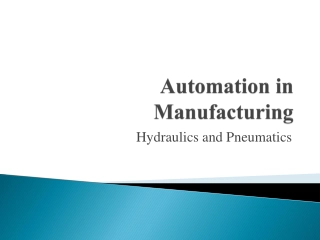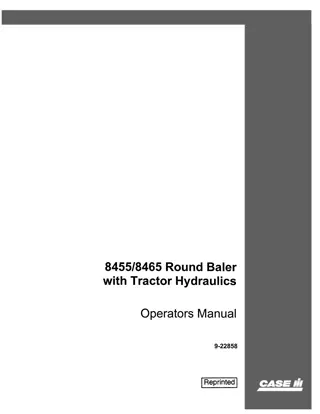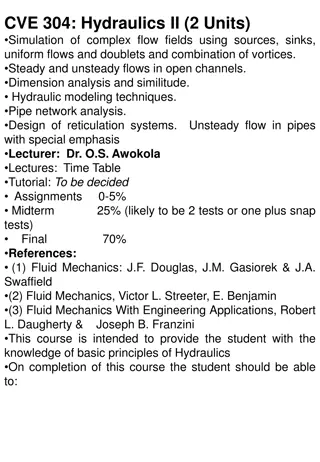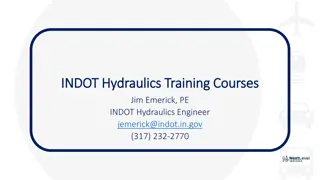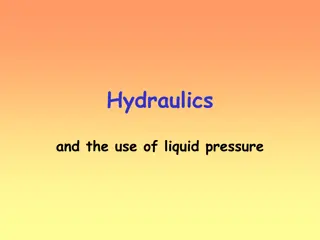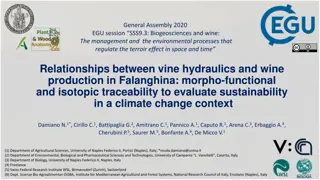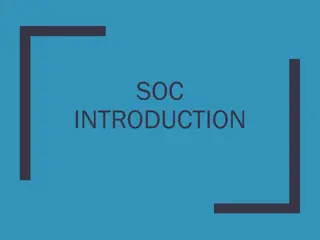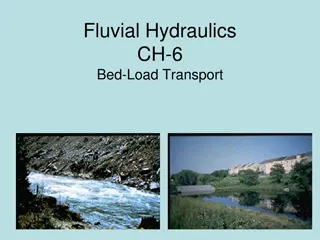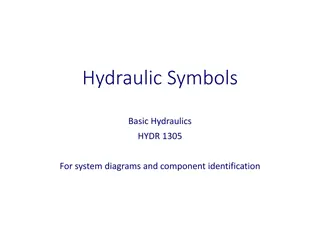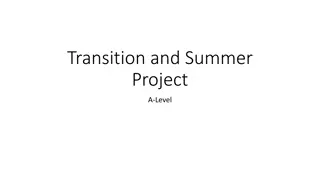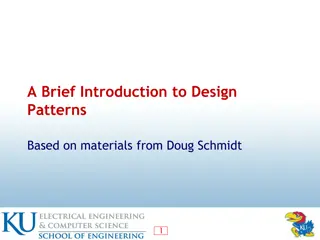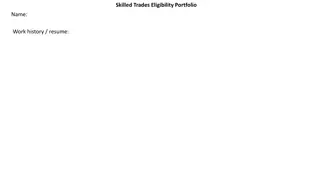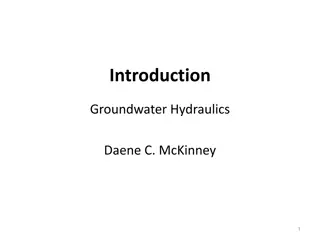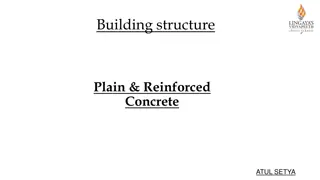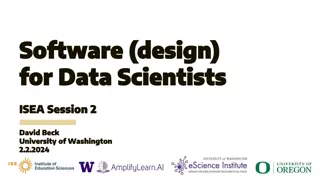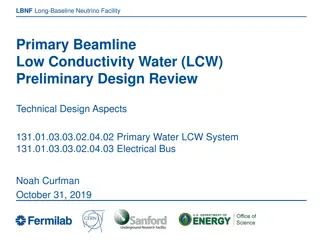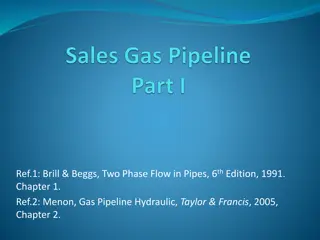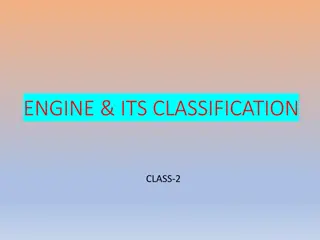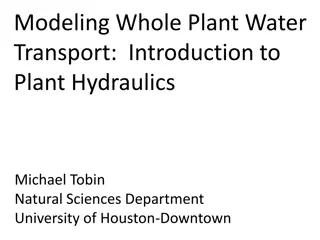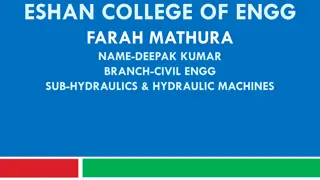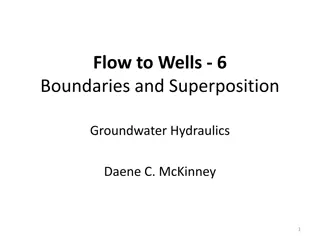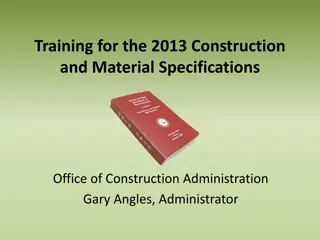Understanding Hydraulics and Pneumatics in Industrial Applications
This chapter explores the structure, advantages, and disadvantages of hydraulic and pneumatic systems utilized in industries for power transmission. Fluid power technology involving liquids or gases confined in systems like hydraulic (using liquid petroleum oils) and pneumatic (using compressed air)
1 views • 18 slides
GCSE Design Technology Knowledge Organiser and Course Structure Overview
In this detailed knowledge organiser, find information about the GCSE Design Technology course structure, learning objectives, mission statement, and core technical principles for KS4 students. The course emphasizes iterative design cycles, creative thinking, problem-solving, and addressing environm
7 views • 53 slides
INDOT Hydraulics Design Guidance Updates and Expectations
Stay updated on the latest design guidance and expectations for 2023 from INDOT's Hydraulics department, including information on replacement procedures, culvert design calculations, manual updates, training courses, and new job opportunities within the organization.
0 views • 48 slides
Introduction to Flood Risk Assessment with HEC-FDA Overview
This presentation delves into flood risk assessment using HEC-FDA software, covering topics such as defining flood risk, components of uncertainty, consequences of flood risk, and methods to assess flood risk including hydrology, hydraulics, geotechnical, and economics. It explores the intersection
6 views • 39 slides
Understanding Software Analysis and Design Process
Software analysis and design involve a systematic approach to understanding user requirements, creating logical models, and transitioning to detailed design specifications. Requirements analysis focuses on capturing system requirements, while design translates these requirements into implementation
7 views • 16 slides
Understanding Fluid Pressure in Oil Field Hydraulics
Explore the fundamentals of fluid pressure including pressure basics, unit conversion, fluid weight constants, true vertical depth, and hydrostatic pressure in the context of oil and gas technology programs. Learn how to calculate pressure gradients, understand the impact of fluid density on pressur
1 views • 40 slides
Case IH 8455 8465 Round Baler with Tractor Hydraulics Operator’s Manual Instant Download (Publication No.9-22858)
Please open the website below to get the complete manual\n\n\/\/
0 views • 22 slides
Understanding Hydraulics II: Simulation and Analysis in Open Channels
Dive into Hydraulics II to explore complex flow fields, dimensional analysis, pipe network analysis, and design of reticulation systems. Learn about steady and unsteady flows in open channels, Chezy's and Manning's equations, and the different flow regimes in open channels. Gain insights into unifor
5 views • 5 slides
INDOT Hydraulics Training Courses Overview
INDOT Hydraulics Training Courses offer education on hydraulics design, aimed at improving quality of submissions, reducing resubmittals, and speeding up reviews. Courses cover topics like Driveway Permit Training, Small Structure and Pipe Hydraulic Design, Storm Sewer and Detention, and Bridge Hydr
0 views • 6 slides
Guidelines for Design of Cement Concrete Pavement and Interlocking Paver Blocks
This document provides guidelines for designing cement concrete pavements and interlocking paver blocks, covering factors governing design, wheel loads, design period, subgrade characteristics, approximate k values based on CBR values, and the importance of a sub-base below concrete pavements. It em
0 views • 67 slides
Software Engineering Design Principles and Concepts
The chapter discusses the essential principles and concepts in software design, highlighting the four key design models - data design, architectural design, interface design, and component-level design. It emphasizes the importance of traceability to the analysis model, minimizing the gap between so
0 views • 36 slides
Understanding Hydraulics and Liquid Pressure
Explore the concept of hydraulics and the use of liquid pressure in various applications, such as car brakes, car jacks, forklift trucks, lifts, bulldozers, and more. Learn how liquid pressure allows forces to be transmitted effectively, enabling the multiplication of forces through piston areas. Di
0 views • 9 slides
Vine Hydraulics and Wine Production in Falanghina: A Study on Sustainability in the Context of Climate Change
This study focuses on analyzing the relationships between vine hydraulics and wine production in Falanghina grapes to evaluate sustainability in the face of climate change challenges. By monitoring resource efficiency and allocation in vine development up to must production, the researchers aim to u
0 views • 7 slides
Understanding System on Chip (SoC) Design and Components
Explore the world of System on Chip (SoC) design, components, and working flow. Learn about Intellectual Properties (IP), platform-based design, typical design flows, top-down design approach, and the emerging Electronic System Level (ESL) design flow. Discover the essential components of an SoC, su
0 views • 45 slides
Exploring Design Inspiration and Elements in Costume and Fashion Design
Dive into the world of costume and fashion design through a visual journey of finding design inspiration, understanding the design process, emphasizing originality, and exploring different sources of creativity. Discover how technology, art, food, history, architecture, and nature can spark innovati
0 views • 45 slides
Understanding Sediment Transport in Fluvial Hydraulics
Sediment transport equations play a crucial role in predicting sediment capacity under different flow conditions, aiding in various analyses like aggradation, degradation, scour, deposition, and migration. Different formulas cater to varied scenarios, distinguishing between bed load and suspended lo
0 views • 82 slides
Enhancing Piping Design Efficiency with Spec-Driven Technology
Explore how Spec-Driven Piping technology powered by CADACTIVE offers a standardized approach for piping design in Creo Parametric. This innovative extension streamlines design communication, eliminates errors, and improves design efficiency by utilizing a master catalog, automated checking capabili
0 views • 15 slides
Material Design: Combining Classic Design Principles with Technological Innovation
Material Design is a design language that combines traditional design principles with the possibilities offered by technology and science. It emphasizes visual language, classic design elements, and innovation to create delightful user experiences. The Material Metaphor, Imagery, Typography, Color,
0 views • 34 slides
Comprehensive Guide to System Design Components and Techniques
System design involves the detailed planning and identification of components in an information system, aiming to provide users with a general understanding of the new system. This process includes techniques like flowcharts, prototyping, and component design, covering aspects such as output design,
0 views • 24 slides
Understanding Design Patterns: A Comprehensive Overview
Exploring the world of design patterns, this content delves into the essence of design patterns, their application in software design to resolve complexity, and the different types of design patterns - creational, structural, and behavioral. It also showcases examples of popular design patterns such
0 views • 22 slides
Understanding Hydraulic Symbols and Equipment in Basic Hydraulics
Explore the world of hydraulic symbols and equipment used in basic hydraulics systems, including flow lines, functional elements, various equipment such as filters, actuators, pressure regulators, and control valve symbols. Learn how to identify components in system diagrams through detailed illustr
0 views • 28 slides
Understanding Basic Concepts in Software Design
Software design involves transforming customer requirements into a form suitable for implementation, with activities categorized into preliminary and detailed design stages. High-level design focuses on module identification and control relationships, while detailed design entails defining data stru
1 views • 24 slides
Understanding Basic Hydraulics in Irrigation Systems
Hydraulics is crucial in designing efficient irrigation systems. This branch of science involves the study of water or liquids in motion, focusing on flow, velocity, pressure relationships, and pressure losses in pipes. Learn how to make cost-effective design decisions and ensure uniform water distr
0 views • 32 slides
Exploring 3D Design and Critical Analysis in Architecture
Dive into the world of 3D design and critical analysis with a focus on architecture. Discover the stages of design, essential skills for designers, and areas of study in three-dimensional design. Delve into iconic buildings like Frank Lloyd Wright's Falling Water, analyze their key features, and eve
0 views • 9 slides
Understanding Design Patterns in Object-Oriented Design
Design patterns in object-oriented design (OOD) are essential templates that codify best practices for solving common problems. They help streamline development by capturing proven design decisions, promoting code reuse, and enhancing system flexibility and modularity. Learn about the core concepts,
0 views • 20 slides
Understanding Interaction Design in Human-Computer Interaction
Interaction design focuses on creating interactive products that are easy, effective, and enjoyable to use. It aims to reduce negative user experiences while enhancing positive ones. Designing interactive products requires understanding user activities, interfaces, and device arrangements to support
0 views • 11 slides
Skilled Trades Eligibility Portfolio with Work History and Resume
This portfolio showcases a range of skills and experiences relevant to skilled trades, including the ability to read prints, knowledge of bearings, fabrication expertise, precision measurement skills, rigging capabilities, pneumatics and hydraulics knowledge, power transmission skills, and education
0 views • 11 slides
SE2811 Software Component Design Overview
This course covers software component design, design patterns, object-oriented design, algorithms, and opportunities for reuse in systems design. It emphasizes the importance of domain-level design and provides insights into solving core problems through reusable classes.
0 views • 21 slides
Understanding Groundwater Hydraulics and Hydrology
Explore the fundamentals of groundwater hydraulics and hydrology in this course, covering topics such as Darcy's law, aquifer testing, unsaturated flow, and more. Dive into practical applications and participate in a team project focusing on limiting hydraulic containment of contaminated aquifers. G
0 views • 25 slides
Analysis of Bunch Lengthening in CEPC for Different Design Parameters
This study explores bunch lengthening in the Circular Electron Positron Collider (CEPC) for various design parameters, analyzing a 54 km design scheme, a 61 km design scheme, and a 100 km design scheme. The analysis includes the theoretical framework used, equations for bunch lengthening, and conclu
1 views • 15 slides
Understanding Plain & Reinforced Concrete Structures in Design Engineering
In the design of Plain & Reinforced Concrete structures, various strength design methods such as Ultimate Strength Design (USD) and Allowable Strength Design (ASD) are utilized. These methods involve factors of safety, material strength, load factors, and analysis in the elastic range. Additionally,
0 views • 11 slides
Verilog Adder Examples & Typical IC Design Flow
This comprehensive content delves into Verilog adder examples, typical IC design flow, physical design considerations, and examples of OpenGL ES GPU and ARM hypervisor applications. It covers the fundamentals of digital logic with Verilog design, hardware description language, FPGA prototyping, phys
0 views • 27 slides
Understanding the Importance of Software Design for Data Scientists
Today's ISEA Session 2 with David Beck from the University of Washington delves into the critical role of intentional software design for data scientists. The session covers the software design approach, user-centric design stories, use cases, components, testing strategies, and the benefits and dra
0 views • 76 slides
Long-Baseline Neutrino Facility (LBNF) Primary Beamline LCW System Overview
The Long-Baseline Neutrino Facility (LBNF) Primary Beamline Low Conductivity Water (LCW) System comprises various technical design aspects including system operational scope, major system updates, design requirements, and component summary. It involves the provision of LCW cooling for magnets and po
0 views • 14 slides
Comprehensive Overview of Two-Phase Flow Equations and Gas Pipeline Hydraulic Analysis
Explore the general flow equations for two-phase flow in pipes and gas pipeline hydraulics. Understand concepts such as internal energy, kinetic energy, potential energy, entropy, and friction factors. Learn about pressure gradients, Reynolds numbers, and friction factors in single-phase gas flow. G
1 views • 26 slides
Understanding Engine Classification and Design
Engine classification involves categorizing engines based on various factors such as combustion type, number of strokes, cylinder design, and ignition method. Common classifications include external and internal combustion engines, as well as categories based on the design and use of the engine. Add
0 views • 11 slides
Understanding Plant Hydraulics: Water Transport and Photosynthesis
Explore the fascinating world of plant hydraulics through the lens of water transport and photosynthesis. Delve into the cohesion-tension theory, air seeding hypothesis, and the impact of soil moisture on plant conductance. Discover the intricate mechanisms that govern how plants move water and nutr
0 views • 13 slides
Understanding Open Channel Hydraulics: Types of Channels, Flows, and More
Gain insights into open channel hydraulics covering topics like types of channels, various flows, velocity distribution, discharge mechanisms, and economical channel sections. Delve deeper into specific energy, hydraulic jump, gradually varied flow, and the distinction between steady/unsteady and un
0 views • 11 slides
Groundwater Hydraulics: Well Pumping and Superposition Analysis
This content delves into various aspects of well pumping in groundwater hydraulics. It covers topics such as boundaries, superposition, confined and unconfined aquifers, pumping near streams, and practical examples. The visuals aid in understanding concepts like drawdown at wells and the effects of
0 views • 30 slides
2013 Construction & Material Specifications Training Overview
This document provides an overview of the training session conducted for the 2013 Construction and Material Specifications. It covers the significant changes introduced, the publication dates of associated documents, key topics discussed in the training sessions, conversion guidelines, and the sched
0 views • 7 slides
